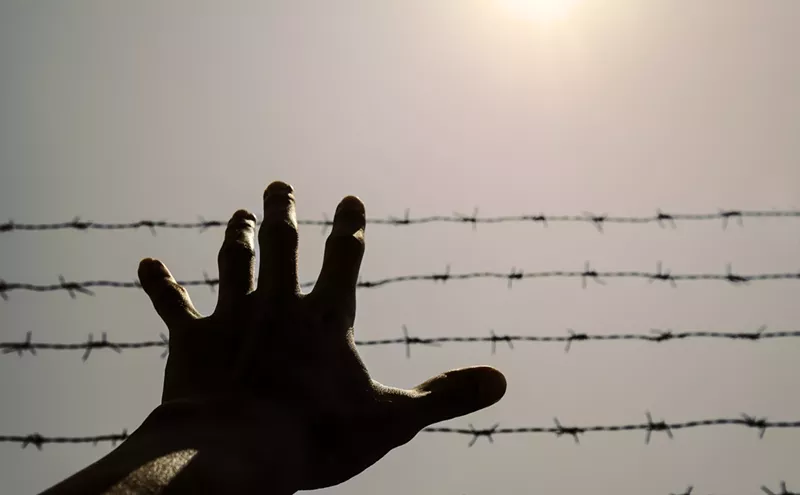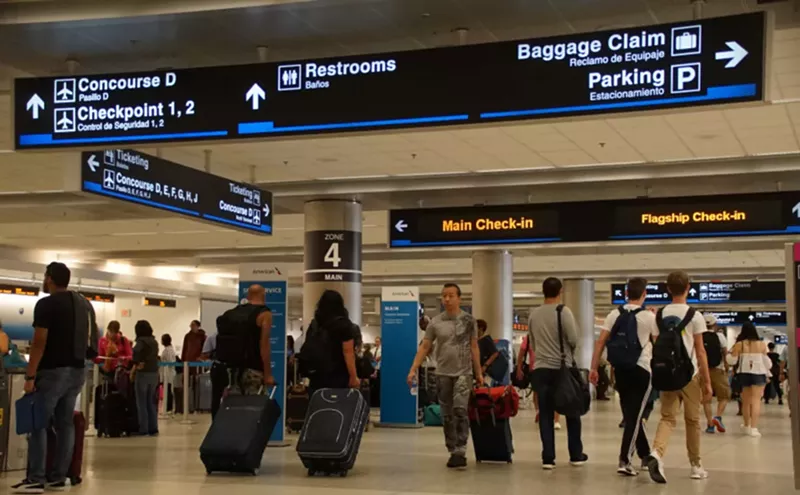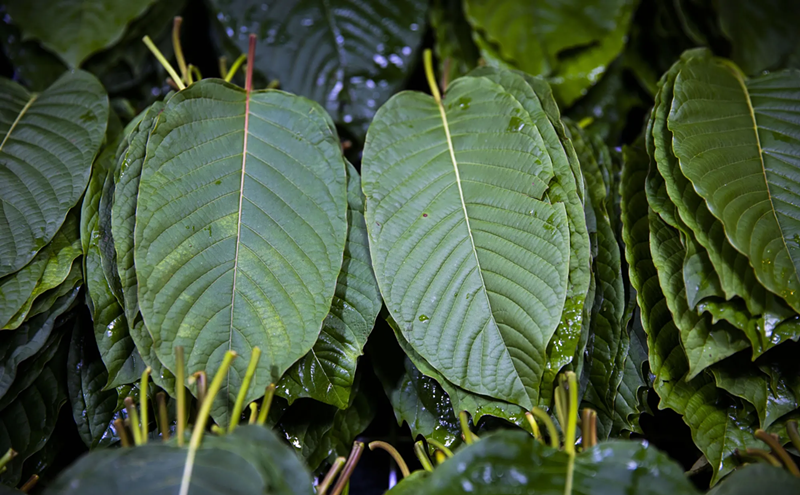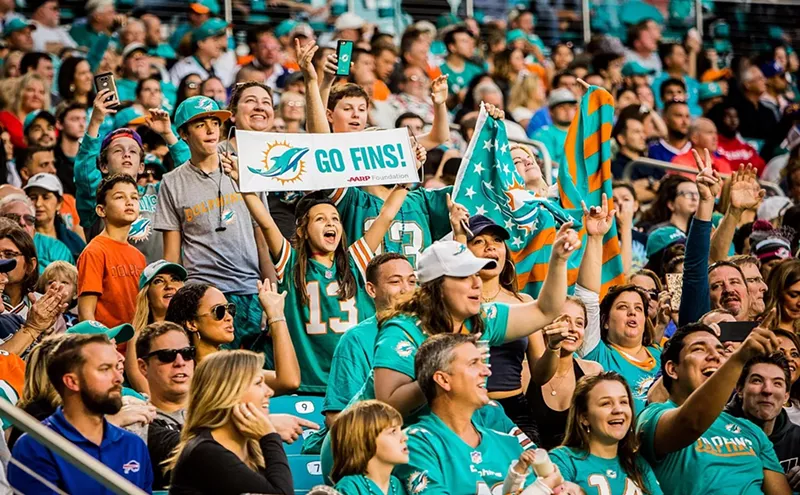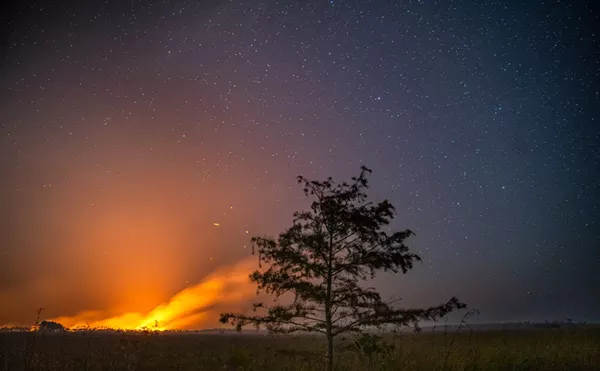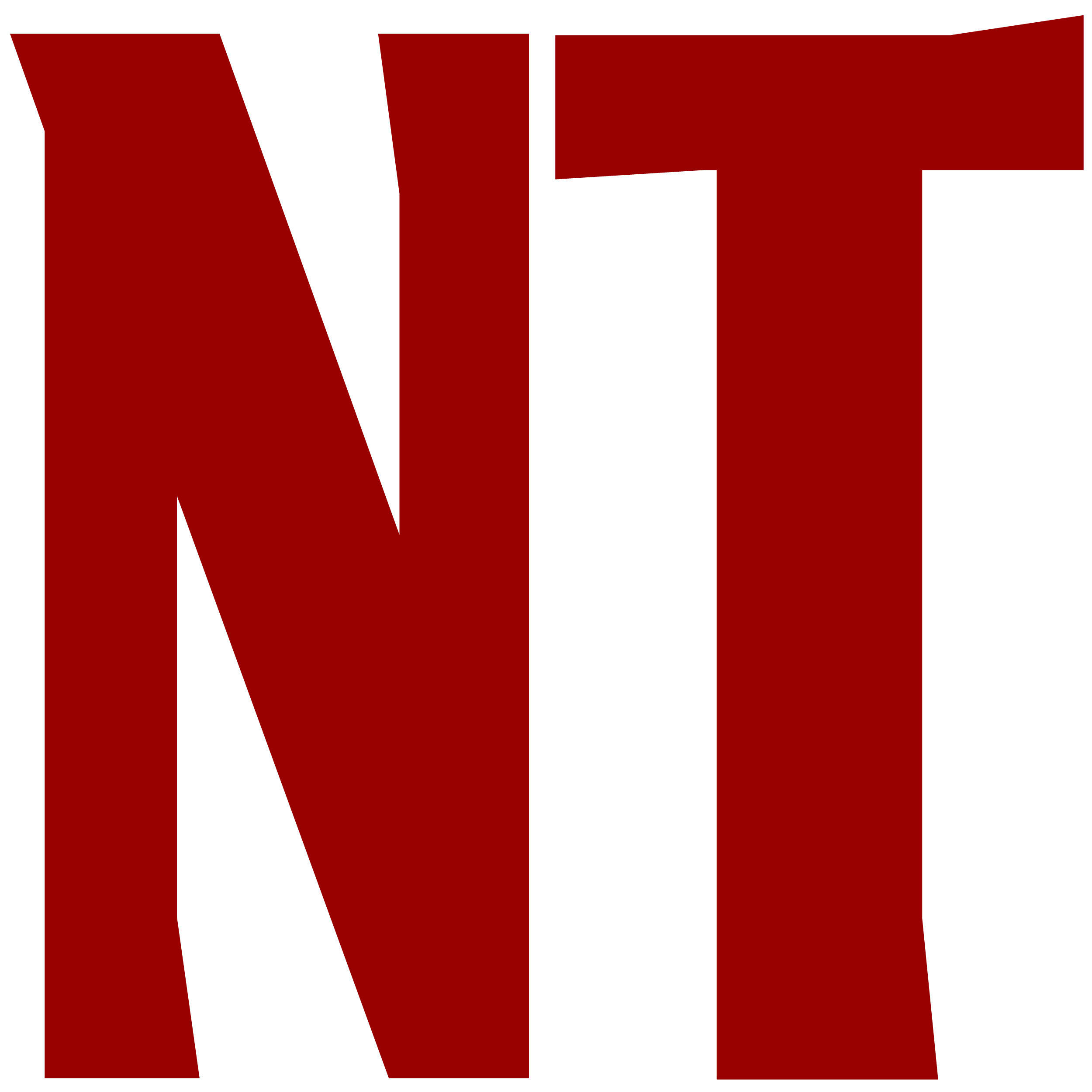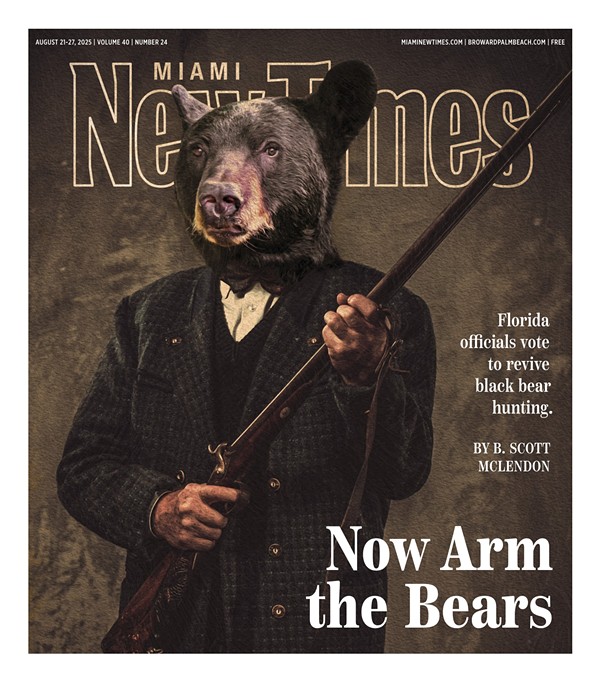Upstairs at the Patricia and Phillip Frost Museum of Science, past smiling employees at the front desk and cubicles full of researchers and staffers, lies a secluded room behind a password-protected door. Inside, unmoving taxidermies of bears, snakes, and birds stand next to rows of sterile bones, shells, and antique instruments of science.
The L-shaped room with industrial ceilings and wooden floors has been dubbed "the Curious Vault." Shelves and drawers are crammed full of every kind of weirdness from the natural and human world, most donated by the public over the past 60-plus years.
On a quiet weekday afternoon in April, I was working in the vault with Kevin Arrow, the museum's art and collections manager, digging through old files. As a writer and researcher for the museum, I've discovered and told the stories of objects that the public has never seen, from a bizarre weather-recording device owned by the Deering family to 1920s paintings made underwater using an experimental pre-scuba machine. With the museum preparing to move everything to its new facility on Biscayne Bay downtown, we've been diving into the darkest corners to catalogue what's hidden there.
That morning, I was skimming through some musty documents, handwritten letters, and crumbling photographs in a vintage-looking green file cabinet. I'd picked up a browned and well-thumbed folder labeled "Florida Archaeology" when two letters and some detailed diagrams fell out onto my lap.
I scanned the documents quickly, glancing at a pair of odd-looking maps. Then an oft-repeated phrase in the letters leapt out: "Pyramids in the Everglades." I looked at the maps again and blurted out, "Kevin."
No answer.
"Kevin!" I yelled more loudly.
"What?" he hollered from a distant corner of the vault.
I held up the papers excitedly. "Is this a damn treasure map?" I demanded.
He rushed over, and we both studied the yellowed papers.
The first map was printed on a large piece of paper, almost a handbill, with circles depicting what appeared to be settlements. A second, normal-size sheet was covered with markings pointing toward another obscure site near the Glades. Attached was a hand-drawn notecard depicting some kind of ancient dagger.
The attached letters only added to the intrigue. In straightforward prose, they described the remnants of a lost civilization in the Florida swamps, including a pyramid guarded by an underground room full of snakes. The writer had seen the ruins with his own eyes.
A buzz stirred my mind. My heart ran neck-to-crotch in a blurry race of excitement. All I could think about was trying to solve the mystery. What were these maps that seemed to point the way toward ancient pyramids in the middle of the Florida wilds, and where did they lead? I had to know.
For the past four months, I've jumped headfirst into tracing their origin. I soon realized they were tied up in the stories of two extraordinary and infinitely curious men.
The first, J. Manson Valentine, is perhaps Miami's foremost gentleman explorer -- a scientist, historian, and world traveler whose lifelong curiosity led him to some strange places, including becoming a world expert on the lost city of Atlantis. An enigmatic former honorary curator of the Miami Science Museum, he's responsible for filling many of the shelves of oddities inside the Curious Vault.
The second key character is a far more shadowy figure, L. Frank Hudson, the author of the letters, who claimed to have made the discovery of a lifetime.
Their tales are two untold chapters in Florida's rich history of treasure hunters, from big-business operations mining ancient shipwrecks in the Florida Keys to fringe characters obsessed with the swamp ape and psychic mediums leading the way to the supposed mysteries of humankind.
These maps, at least, sure looked real. So Kevin and I put on our Indiana Jones hats. We joked about how the discovery was a meal ticket, a passage to a lost civilization and enduring archaeological fame, but I knew the reality was that it was a call for further investigation, a quest I couldn't resist.
It was a call to find something.
Before I could try to decipher the maps or understand the letters, I knew I'd need to understand the man at the center of it. Valentine's name may not be famous in Miami, but for decades he was a major face of science around town -- and briefly, as I learned, rocketed to international fame for a more dubious achievement: a discovery hailed, for a time, as the key to the lost civilization of Atlantis.
Joseph Manson Valentine was born in 1902 in New York City. He earned a BA from Yale University in 1923 and went on to receive a doctorate in zoology from the Ivy League institution.
Soon after graduating, Valentine began traveling on scientific expeditions, including an ornithological survey to Panama with the American Museum of Natural History. He later taught zoology at Yale and the University of North Carolina while still exploring and focusing on entomology. Valentine traveled far and wide -- all over the United States, Europe, Northern Africa, the Caribbean, and Central America. It might be easier to pin the places on a map where he hadn't turned over a rock.
Along the way, he contributed to the scientific canon: He published extensively and even has a handful of obscure beetles named after him. In 1957, he moved to Miami and was soon made honorary curator at the Miami Museum of Science, a position he would hold for nearly four decades until just before his death, when he quit over philosophical differences.
Friends and relatives describe Valentine as a man with a larger-than-life personality, enthusiastic in his studies and extremely knowledgeable about a great deal of subjects.
"He looked like a college professor who had no problem jumping into a roomful of snakes in the Yucatán," says Albert Weintraub, an attorney and former Miami Science Museum director Claire Weintraub's son, who traveled extensively with Valentine.
During a research trip to the Bahamas in 1969, Valentine noted a strange geological formation just off the island of Bimini. More than 300 feet long, the site included curving, megalithic submerged rocks that by all appearances were manmade, with abnormally smooth surfaces and apparently deliberately arranged positions.
alentine nicknamed the feature "Bimini Road" and published his findings in the science museum's Muse News. Though Valentine never included the word "Atlantis" in the piece, the story soon spread across the nation and became linked to the lost city. Scholars have searched for the famed locale ever since Plato famously wrote that it had sunk under the Atlantic waves. To some, Valentine's mysterious formation offered new hope: Perhaps it had been sitting off the coast of Florida all along.
"He was careful not to say it was Atlantis," Weintraub says, "careful not to get into a pissing match with anyone."
But Valentine's longtime dream was finding an ancient lost culture, and even if he wasn't completely convinced he had found the mythical city of Atlantis, he did think the Bimini Road formation was something worth studying further.
His association with Atlantis led some scientific colleagues in Miami to scoff at the respected old scientist, though. One contemporary, a University of Miami geologist named Eugene Shinn, debunked rocks from the site as natural formations. Ed Petuch, a zoologist at Florida Atlantic University, says he viewed Valentine as "a kind older gentleman who had a wonderful shell collection... and was very knowledgeable about shells and marine biology." When it came to Bimini Road, though, Petuch also saw him as "a geological crackpot."
Valentine may have simply been before his time. In an era when Atlantis specials are regular occurrences on the History Channel, he might have found more acceptance in the internet age. "[He] had a lot of people trying to deride him and demeaning his activities, but he was very curious," Weintraub says. "He had some characteristics that right now you see a lot of on TV shows, way before anyone was into that."
There was one side effect to Valentine's sudden brush with Atlantis infamy. It made the Miami-based scholar a magnet for other fringe explorers and borderline crackpots.
Photos from the years after his discovery show Valentine meeting with mediums with their hands hovering over maps; countless other conspiracy theorists and wannabe explorers flooded Valentine with pages of arcane and indecipherable script. Many of those letters are now carefully archived in the museum.
The most intriguing of those correspondences landed in Valentine's lap right after the Atlantis hullabaloo. They were filed away and sat in the museum's basement for years -- until we found them in April.
The letters are typed on aged paper and addressed to Valentine. The first was mailed in April 1970, and the second in June 1971. Both make an outrageous claim in starkly calm language -- namely, that there are undiscovered pyramids throughout the Everglades and other parts of Florida from an unknown civilization.
"I recently talked with a man who lives on a ranch near Immokalee who claims to have been in the Big Pyramid in the Big Cypress Swamp," L. Frank Hudson writes in the first yellowed letter. "He says there is a stairs [sic] leading down from the room into an underground passage which is full of snakes."
The next letter, from 1971 on greenish paper with a stylized typeface, was even more concrete, claiming, "We visited a small stone Pyramid, made of smoothe [sic] faced stone. It reaches down in the ground as far as a probing rod will go. [sic] which makes me think that it may be down to bed rock which is 65 feet deep. Nearby is a mile long wall."
Hudson, in other words, had seen these pyramids. And there are more, he wrote, because "the same man told me of visiting or rather of seeing a simmilar [sic] stone pyramid in the middle of a mangrove swamp just off Lostmans river in the 10,000 island... I've also been told of a Stone Pyramid with a room inside sitting in the middle of a cow pasture just off the Peace River on a Florida Ranch with still another wall nearby. I'm beginning to think that the Lost civilization here in Florida may have been far more extensive than I first imagined."
Hudson never identifies his source, though he mentions the man "can also show us numerous Everglades complexes."
Florida, of course, was home to more than a dozen ancient civilizations. The Calusa, Tequesta, Timucua, and other tribes called the Sunshine State home for many generations before Ponce de Leon landed near St. Augustine. But none were Mayan-like builders, and zero credible evidence exists of large-scale pyramids in the state, yet Hudson writes matter-of-factly about finding them.
But who was this letter-writer, and how credible were his claims?
Born in 1918, Hudson was a true Florida character -- a man obsessed with buried treasure, a disseminator of hard-to-pin-down tales, and, like Valentine, an obsessive explorer.
Even to his closest friends, he was sketchy about his past. He told many he was a spy for the OSS, the arm of the government that became the CIA after World War II. He claimed to have helped rescue a German prince jailed by Hitler and did work of an undefined and unexplained nature in Panama. His wildest stories came with a straight face and a stoic nature.
"He didn't have much of a sense of humor," says Peter Smitt, a St. Petersburg resident who became a friend of Hudson's and helped care for him in his later years, when he heard many of his more outlandish tales.
What is clear is that Hudson carved out a niche for himself in a state with a rich and colorful shadow industry of men conspiring to find long-buried Spanish treasure chests and hidden shipwrecks. By the 1960s, Key West had become a hotbed for hunters probing the seabed and shorelines for lost gold -- a trend that exploded in 1985 when Mel Fisher found the wrecked galleon Atocha and the $400 million in treasure it carried.
Hudson began publishing books and articles about the subject. In 1973, he collaborated with another Florida hunter, Gordon R. Prescott, to publish Lost Treasure of Florida's Gulf Coast. A more widely circulated tome came in 1988, How to Discover and Profit From Florida's Shipwreck Treasures. As the name suggests, Hudson was concerned with banking on the treasure as much as the thrill of discovery itself.
"Let's call a spade a spade. He was a treasure hunter," says Bob Carr, the executive director of Florida's Archaeological and Historical Conservancy and author of Digging Miami.
Hudson had another side, one that led to his nickname, "Wild Man Frank." Along with Prescott, he founded one of the first groups obsessed with finding Florida's skunk ape, the misleadingly named Yeti Research Society. The group made headlines throughout the '70s with claims it was onto the mythical beasts.
"We've seen their tracks, heard them, and witnessed a pair of pinkish, reflective eyes staring at us," Prescott told the Panama City News Herald in 1975.
"We were close, but apparently not close enough," Hudson lamented to the paper.
Hudson was full of other fantastic assertions as well. He claimed to have traveled to the Archivo General de Indias in Seville, the main historic archive about Spain's early explorations in America, to learn about unreported shipwrecks. He also bragged that his former work as a spy left him with inside info, including clues about gold bars buried by the U.S. government on an island off the coast of Cuba, meant to pay off top officials in the event of Castro's assassination.
Even while publishing books and his long-running newsletter, Hidden Wealth, he always had the air of a man working on a big, secret score. "He struck me as someone who was working the deal all the time, very careful about what he said, trying to identify potential donors or investors, and kept his cards close," Carr says.
By the late '90s, Hudson was pitching investors on his biggest deal yet, his own personal Atocha. Through his archival research, he said, he'd found the mother lode: a clue to a hidden cache buried by none other than José Gaspar -- also known as Gasparilla, the legendary Spanish pirate said to have haunted Florida's Gulf Coast in the late 18th Century.
Hudson raised thousands of dollars, rented backhoes, and recruited other treasure hunters and their equipment. He started on Weedon Island, a mass of tangled mangroves east of St. Petersburg, and dug 15-foot-long trenches. The treasure hunters moved on to Big Mound Key, a nationally protected island where the remains of a Calusa Indian tribe from 1,000 A.D. are buried. They plowed a 130-foot gash into one mound. When Hudson came up empty, the enterprise moved to other nearby spots -- Cockroach Island and Ross Island -- before hitting up Cayo Costa, a state preserve off Cape Coral, where scouts watched in trees for park rangers as the bulldozer plowed 30-foot holes.
It was a risk too far, and the authorities soon nabbed the crew. Hudson, his accomplices, and his friend Smitt (who claims the Cayo Costa dig was his first trip with Frank), were charged with racketeering, grand theft, and criminal mischief. Historians fumed. "This was the most intense vandalism, the most serious destruction of any archaeological site conducted illegally anywhere in Florida,'' state archaeologist James J. Miller told the St. Petersburg Times.
Hudson pleaded to reporters that he was just trying to solve a long-held archaeological mystery, adding, "I'm more interested in archaeology than I am in treasure."
But whatever his motives, prosecutors say one thing was never in serious doubt: Hudson's conviction that he'd found a legitimate lead on long-lost Spanish treasure.
"There's no doubt in my mind Hudson sincerely believed he was going to find José Gaspar's gold,'' Assistant State Attorney Bob Lee said in court.
Hudson got off light with five years of probation. But the court also ordered him to stop writing about or promoting the practice of treasure hunting. It was essentially a death knell for his dreams. After the caper, Smitt helped take care of Hudson, who was then massively overweight and diabetic. "All he'd buy is junk food," Smitt says. He died broke a few years after his arrest.
Through it all, in a dark corner of Manson Valentine's archives, two of Hudson's letters and a series of maps lay forgotten. Were they another lark of Wild Man Frank's? Or, as even prosecutors admitted, were they another instance where he sincerely believed he had found something remarkable?
There was only one way to find out. It was time to follow the maps.
I knew trying to retrace Hudson's steps 40 years later would be a huge challenge. Was it even possible that undiscovered structures are still sitting out in the Everglades?
Well, long-lost structures sunken into the slough can be found. Just this summer, three amateur explorers found the remnants of Fort Harrell, an 1837 U.S. Army fort used as an outpost during the Seminole Wars that had been missing for more than a century in Big Cypress National Preserve. The Glades are vast and unforgiving enough that structures indeed go missing and eventually turn up again. Fort Harrell's discoverers logged more than 100 hours in the field searching alone, to say nothing of the research involved.
One hapless writer could hardly hope to put in that much commitment. But then again, I had what they didn't: a treasure map. Actually, I had two of them, plus all of Hudsons' writings describing the lost pyramids he said he found at the sites.
The first map I investigated is the size of a piece of standard printer paper and is labeled an exploration site record, which is an official tool used by archaeologists to diagram out a site dig. It's a topographical drawing that seems to show an Indian mound amid a vast wilderness.
As I studied the map, I quickly hit a dead end. The document is labeled in all caps: "ON THE EDGE OF GLADES TO EAST OF BIG CYPRESS." It points the way to a site near the nature preserve on the east side of the Everglades, but no exact coordinates are included. It's almost a giant middle finger hovering over some of the most remote wilderness on the planet.
Accompanying the record is a hand-drawn picture of an ancient-looking dagger, which Carr says would be a significant historical find in Florida if real. The drawing of the knife, intriguingly, is in Valentine's hand -- not Hudson's -- but there is no other mention of the weapon (and no sign of the knife itself) in his archives at the museum.
Still, it is a map. I began calling airboat captains and explaining the situation. Would it be possible to go looking for a pyramid near Big Cypress using the document?
No, I was told time and again, not without some coordinates. I even spoke with an aerial archaeologist who has found significant sites in the swamp on flyovers. Without more concrete information, he said, it would simply be too expensive to try.
The Big Cypress map, barring a National Geographic-style expedition during hurricane season into one of the most treacherous landscapes on Earth, was officially a no-go.
So I turned my attention to the second, larger map. The site, I soon realized, was far more clear: a patch of land just outside Malabar, a small town on the Atlantic Coast south of Melbourne.
And as I dug into the history of the site, my excitement grew. This wasn't just any random field on the edge of the Everglades. The Malabar map pointed the way to a real historical site, a place called the South Indian Field mound.
The site was owned and initially excavated in 1927 by an amateur archaeologist named A.T. Anderson and his son. Anderson was digging a hole in the ground for a well and found arrowheads, potsherds, and animal bones. He dug his land for the next 22 years, turning the plot into a de facto roadside attraction, inviting tourists and neighbors to see the property and often giving away or selling artifacts. Eventually, in the 1950s, a Yale archaeological team caught wind of the site and swooped in to do a full survey.
That survey came nearly two decades before Hudson's letters to Valentine, though. Had he found something there that the Yale team had missed? It seemed doubtful, but the land was certainly remote enough to hide secrets.
Two weeks ago, I set out on my own to find out. The state's water treatment authorities now own the plot, and after a round of calls through the bureaucracy -- which was not equipped to deal with someone searching for long-lost pyramids -- I finagled permission to visit.
It was a sweltering August Saturday morning when I drove up to the land, accessible by a dirt road 15 minutes off I-95. I imagined the two explorers, Valentine and Hudson, trekking onto the 32-acre plot 40 years earlier, looking at the same masses of palmettos and sawgrass.
The Indians who lived here, possibly the Timucua, would have used the land for the same reason the State of Florida now uses it: good access to fresh water. In some places, the ground was still covered in shells. The native Floridians lived inland in the winter, surviving on a diet of snails and whatever else could be carried from the sea, littering the area with shells. The buildup was a memento of their lives, left throughout the centuries.
As for an ancient pyramid, though, there was none to be found. What did Malabar mean to Valentine or Hudson?
Without specific notes tied to this map, it's impossible to know. The trip did leave me thinking about the Indian mounds that quietly dot the landscape around Florida.
The next day, I visited another Timucuan mound, this one in Hontoon Island State Park, right outside the Ocala National Forest. A two-mile hike from the visitor center leads to a massive midden, startling in the flat landscape.
These mounds, in their own way, are pyramids tucked away in the Florida swamp. Maybe Hudson wasn't so crazy after all?
Then again, I had yet to see any snake-filled rooms.
My trip to Malabar had been frustrating. The maps hadn't panned out, and without a major expedition to the mysterious corners of Big Cypress, I was running out of options to find the truth behind Hudson's mysterious claims. Perhaps, I began to think, Hudson was just looking to capitalize on the fame Valentine had found with his Bimini Road discovery. Maybe it was a long con and Hudson hoped to bring him in on the type of scheme that later led to his arrest. Maybe the maps weren't related at all.
But then I got in touch with Mike Forte, an author whose day job is in glow-in-the-dark paint sales and manufacturing.
He's seen the pyramids, he said.
Forte lays claim to the rights to Wild Man Frank's life story and writings, which he acquired from Hudson's sister, who recently passed away. "Frank led a double life and was the craziest son of a bitch that ever lived. Had more balls than anybody," he said. Forte, who didn't know Hudson, spends his free time making sense of Hudson's searches for lost civilizations.
Forte claimed Hudson was into more than just treasure hunting. In fact, his dealings crossed him with "heavyweight people." Those people are now onto Forte, he said, and he'd already had me "thoroughly checked out" before even talking to me.
Despite myself, I found my heart beating a little faster again. The same excitement that had coursed through my body when I found Hudson's letters and the maps erupted again. Here was a man who had actually seen the pyramids!
Where were they? The more we talked, though, the more it became clear that Forte had no intention of answering that question -- or of disclosing anything else he knows about the subject. Forte plans to release a book about Hudson and ancient civilizations in Florida, he said, possibly later this year.
In a later email, he clarified he hasn't seen pyramids in the Everglades specifically, but he has seen them in other parts of Florida. He mentioned diving to a lost city, somewhere off the coast, and his hopes of finding and putting it all back together. His message is difficult to follow.
Thus Forte, like so many other players in this tale, was another dead end -- possibly unreliable, certainly unusable.
Bob Carr, for one, knows the type too well. Both Hudson and Forte have pushed him on the same subject. But the respected South Florida archaeologist has never seen a pyramid and doesn't think any exist in the Everglades or elsewhere in Florida.
What's the truth? Carr believes the whole myth can be traced back to one man, Vernon Lamme, Florida's first state archaeologist, who was also convinced there were pyramids out in the unexplored wilderness. Lamme wrote a book titled Florida Lore that linked the Maya, the great pyramid builders of Mexico, to the swamp. He even claimed to have spotted a pyramid on a dirigible flight over the Everglades.
But Lamme wasn't trained as an archaeologist and had a flair for the dramatic. The idea that the Maya traveled to Florida is "a little bit ethnocentric, and it's racist," Carr claims, because it implies that the Native Americans of Florida were incapable of constructing complex civilizations on their own.
In fact, those 15 tribes that covered the state of Florida before the Spanish showed up are probably the real reason behind the enduring myth of pyramids in the Sunshine State. They left behind their own "great architectural presence," Carr says -- hundreds of mounds, some the accumulated waste remnants of hundreds or thousands of years, and some ceremonial, from burial mounds to places of worship.
Carr thinks worship mounds probably helped fuel the rumors. Most aren't built with stones but rather sand, shell, and wood, all of which can gleam white like limestone and from the air might resemble a pyramid. "I have seen no other evidence," he says definitively.
Traci Ardren, an associate professor of anthropology at the University of Miami, agrees. Although the Gulf Stream would probably have allowed Mayans to "jump off a wooden canoe in Cozumel and end up in Florida," she says, "nobody has ever found anything that holds up to actual scrutiny" that they made such a treacherous trip and then set up a now-lost empire.
I was inclined to agree with both the experts and close the door on my career as a ruin-hunting explorer.
Then I spoke to Albert Weintraub, the attorney and Valentine's good friend. He nonchalantly dropped a bombshell in the middle of the conversation: He had also seen the pyramids. With Valentine.
"There were no steps. It had eroded and it was vine-covered -- roots and things like that that had broken it down -- but their outline was there. We measured it as best we could do. It was a pyramidal shape," he said. "They were about 16 to 17 feet, a square pyramidal shape, and built in the same sort of way that the Mayan pyramid structure was."
My eyebrows nearly shot off my face. Where were they?
That's the catch. Weintraub is an old man now. He's doesn't exactly remember.
Perhaps they're south of the airport somewhere in Immokalee, right up against the 10,000 Islands, he guessed. It was years ago, and at the time, he said, he didn't think it was a big deal. After all, he and Valentine had dived Bimini Road together. He had watched Valentine lower himself into an ancient Maya tomb in the Yucatán. They'd been on countless adventures, and this was but another.
Had he and Valentine followed Hudson's advice and found something remarkable that's still out there?
Unless another map tumbles out of the Curious Vault, we may never know.
Follow Miami New Times on Facebook and Twitter @MiamiNewTimes.



